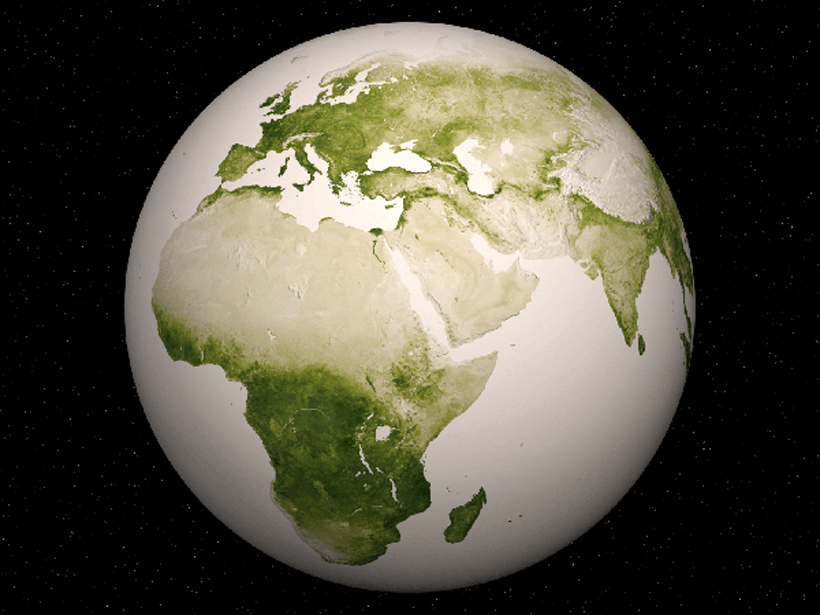Was Earth destined to be a haven for life? Despite being dealt a favorable orbital and geochemical hand, new research suggests the relative climatic stability Earth enjoyed for billions of years is a rare gift subject to the whims of chance.
A time-lapse movie of the average planet’s life would make for a Hollywood blockbuster, as worlds jostle and collide, comets rain down, and the occasional supernova bathes the surface in electromagnetic rays. As a result, researchers have looked for unique feedback mechanisms to explain Earth’s continued habitability, such as silicate weathering and the influence of life itself (the Gaia hypothesis).
Planetary habitability is like show business. To succeed, you need both talent and good luck.
Dave Waltham, a professor of Earth sciences at Royal Holloway, University of London, looked away from geological and biological feedbacks and toward chance in his book Lucky Planet. It took inspiration from the weak anthropic principle, defined as a planetary habitability survivor bias. If the universe starts with billions of potentially life supporting planets, the principle states, the majority of them will fall by the wayside. However, the weight of numbers alone means a few planets are able to stay on track for habitability, even without any feedback mechanisms. Those few fortunate worlds would inevitably be the only ones where intelligent life might be possible.
“Planetary habitability is like show business. To succeed, you need both talent and good luck,” said Waltham.
A new analysis supports the role of chance. Toby Tyrrell, a professor of Earth science at the University of Southampton in the United Kingdom, simulated 100,000 worlds, allowing each to evolve 100 times over billions of years within a differential equation model. Surface temperature, a simplified proxy for habitability, was randomly assigned to each world at the beginning of its evolutionary journey, and the worlds were left to the mercy of two influencing factors. The first factor represented the combined impact of long-term geological, biological, and atmospheric processes present on each world. The second was randomized elements of chance, which were given varying degrees of influence and represented everything from solar flares and interior radioactive decay to asteroid impacts and volcanic supereruptions. Tyrrell then recorded each world’s propensity to retain habitable surface temperatures, defined as being between −10°C and 60°C, during each run.
It seems it was far from inevitable that Earth would stay habitable when it first started out.
Around 9% of Tyrrell’s worlds stayed habitable for the entire 3-billion-year simulation at least once out of their 100 runs, and one planet was successful on all 100 occasions. Most worlds remained habitable less than half the time, however, and more than half succeeded fewer than 10 times, which Tyrrell says points to a reliance on chance. Further analysis suggested only a 39% chance that a planet that stayed habitable in one run would do the same the next time.
“These results point strongly towards both chance and mechanism influencing whether a planet will host life. It seems it was far from inevitable that Earth would stay habitable when it first started out,” said Tyrrell.
Tyrrell’s results were published in Nature Communications Earth and Environment.
Thought-Provoking Research
Yale University’s Noah Planavsky was enthusiastic about the research. “This is an incredibly important and thought-provoking study,” he said. “It is paradigm-shifting in that, arguably, as a community we just haven’t tried to think meaningfully about the role of chance in long-term planetary habitability.”
Waltham is more reserved, suggesting the results were somewhat inevitable.
“Tyrrell’s model incorporates both good luck and good stability and then demonstrates that the results are incompatible with either on its own,” he said. “This may seem like circular reasoning, but the Daisyworld models beloved by Gaia enthusiasts have the same problem, and in both cases, the models show that the concepts can work in principle.”
—James Romero (@mrjamesromero), Science Writer
Citation:
Romero, J. (2021), Chance the hacker: How Earth stayed habitable, Eos, 102, https://doi.org/10.1029/2021EO154236. Published on 03 February 2021.
Text © 2021. The authors. CC BY-NC-ND 3.0
Except where otherwise noted, images are subject to copyright. Any reuse without express permission from the copyright owner is prohibited.

